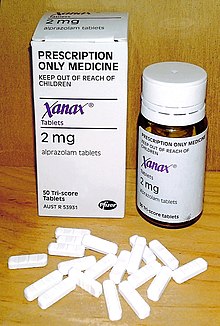Benzodiazepine
Benzodiazepines are organic chemical substances, made of two carbon rings. Certain benzodiazepines can be used as drugs that increase the effect of the neurotransmitter GABA. The resulting drug has sedative effects. Depending on the drug, the effect may be stronger or weaker. The first benzodiazepine, chlordiazepoxide (Librium), was discovered accidentally by Leo Sternbach in 1955, and made available in 1960 by the medicine company Hoffmann–La Roche.


In general taking benzodiazepines is safe and effective in the short term. Longer term use is controversial: In the long term, the drug may become less effective and problems of dependency may show.
Benzodiazepines may not be safe to be taken during pregnancy. They are not teratogens, which cause birth defects, but they may cause cleft palate in a small number of babies. Benzodiazepines can be taken in overdoses and can cause dangerous deep unconsciousness. However, they are much less toxic than the drugs they replaced, the barbiturates. Death rarely results when a benzodiazepine is the only drug taken. When combined with other central nervous system depressants such as alcohol and opiates, the potential for toxicity increases.[1] Benzodiazepines are commonly misused and taken in combination with other drugs of abuse.[2][3][4][5]
Benzodiazepine effects & withdrawal symptoms
changeBenzodiazepines affect the central nervous system, increasing the effects of the inhibitory neurotransmitter known as GABA. This results in a person experiencing a sensation of calmness and sedation, resulting in feeling more relaxed, less anxious, and increased drowsiness. When people use benzodiazepines, even under a doctor’s care, they can develop a tolerance, which means that they will require increasingly larger doses to achieve the desired effects. With escalating use and at higher doses, a person may find that they require the drug to feel and function normally. This indicates the development of dependence which, once established, may result in a person experiencing symptoms of withdrawal.[6]
Long-term, compulsive, or otherwise problematic use of benzodiazepines can lead to significant physical dependence and a higher risk of experiencing severe withdrawal symptoms, which may include seizures and hallucinations. Supervised medical treatment is usually recommended for people who are undergoing benzodiazepine withdrawal after a period of consistent use.
Related pages
changeReferences
change- ↑ Fraser AD (1998). "Use and abuse of the benzodiazepines". Ther Drug Monit. 20 (5): 481–9. doi:10.1097/00007691-199810000-00007. PMC 2536139. PMID 9780123.
- ↑ "Benzodiazepine Addiction". Recovery First Treatment Center. Retrieved 2021-04-10.
- ↑ Charlson F, Degenhardt L, McLaren J, Hall W, Lynskey M (2009). "A systematic review of research examining benzodiazepine-related mortality". Pharmacoepidemiol Drug Saf. 18 (2): 93–103. doi:10.1002/pds.1694. PMID 19125401. S2CID 20125264.
{{cite journal}}: CS1 maint: multiple names: authors list (link) - ↑ Longo LP, Johnson B (April 2000). "Addiction: Part I. Benzodiazepines--side effects, abuse risk and alternatives". Am Fam Physician. 61 (7): 2121–8. PMID 10779253. Archived from the original on 2008-05-12. Retrieved 2010-05-05.
- ↑ Lader MH (1999). "Limitations on the use of benzodiazepines in anxiety and insomnia: are they justified?". Eur Neuropsychopharmacol. 9 (Suppl 6): S399–405. doi:10.1016/S0924-977X(99)00051-6. PMID 10622686. S2CID 43443180.
- ↑ April 16, Scot ThomasLast updated on; 2021. "Benzodiazepine Withdrawal Guide". Withdrawal. Retrieved 2021-05-18.
{{cite web}}:|last2=has numeric name (help)CS1 maint: numeric names: authors list (link)